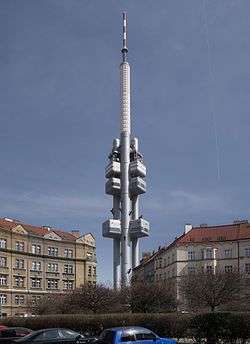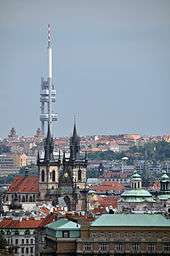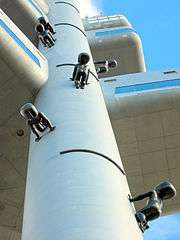Žižkov Television Tower
| Žižkov Television Tower | |
|---|---|
 Žižkov TV Tower | |
| General information | |
| Location | Prague, Czech Republic |
| Construction started | 1985 |
| Completed | 1992 |
| Height | |
| Antenna spire | 216 metres |
| Design and construction | |
| Architect | Václav Aulický |
| Structural engineer | Jiří Kozák |
The Žižkov Television Tower (Czech: Žižkovský vysílač) is a unique transmitter tower built in Prague between 1985 and 1992. Designed by the architect Václav Aulický and the structural engineer Jiří Kozák,[1] it stands high above the city's traditional skyline from its position on top of a hill in the district of Žižkov, from which it takes its name. The tower is an example of high-tech architecture.
Characteristics


The structure of the tower is unconventional, based on a triangle whose corners are growing up in steel columns, consisting of three tubes with a double steel wall, filled with concrete. They support nine 'pods' and three decks for transmitting equipment. One of the three pillars extends considerably higher than the others, and this provides both the necessary height for some antennas, along with the structure's rocket and gantry appearance. In its time it was a unique technology, which authors have patented.
The tower stands 216 metres (709 feet) high, altitude of the observatory is 93 m, the hotel room altitude is 70 m, restaurants altitude is 66 m, with a capacity of 180 people. Three elevators transport passengers at a speed of 4 m/s.[2]
Three of the pods, positioned directly beneath the decks at the top of the tower, are used for equipment related to the tower's primary function and are inaccessible to the public. The remaining six pods are open to visitors, providing a panoramic view of Prague and the surrounding area. The lower three, approximately half-way up the length of the pillars at 63 metres (207 feet), house a recently refurbished restaurant and café bar.
Construction of the tower cost $19 million. It weighs 11,800 tons and is also used as a meteorological observatory. It is a member of the World Federation of Great Towers.[3]
Reputation
Like many examples of communist-era architecture in Central and Eastern Europe, the TV tower used to be generally resented by the local inhabitants. It also received a spate of nicknames, mostly alluding to its rocket-like shape, e.g. "Baikonur" after Soviet cosmodrome or some more political, like "Jakeš's finger" ("Jakešův prst"), after the Secretary General of the Czechoslovak Communist Party. In 2009, Australian website Virtualtourist.com called Žižkov TV Tower the second ugliest building in the world, behind the Morris A. Mechanic Theatre in Baltimore.[4] Recently, the tower's reputation among Czechs has improved.[5] Today the tower attracts visitors with its technological innovations and view over the city skyline.
Although official criticism during the time of its construction was impossible, unofficially the tower was lambasted for its 'megalomania', its 'jarring' effect on the Prague skyline, and for destroying part of a centuries-old Old Jewish cemetery in Žižkov situated at the tower's foundations. Burials in the cemetery ended up in 1890. In 1960 the place was converted to Mahler's park. One-quarter of the cemetery was preserved, at three-quarters of the cemetery tombstones were tumbled and covered with a thick layer of soil. But during the tower's foundation was simply dug up through the layer of the cemetery, tombstones were crushed by heavy equipment and with the bones carried away to landfill.[6] However, the official line remains that the cemetery was moved some time before the tower was conceived.
Last changes

.jpg)
David Černý sculptures
In 2000, ten fiberglass sculptures by Czech artist David Černý called "Miminka" (Babies), crawling up and down were temporarily attached to the tower's pillars. The sculptures were admired by many and were returned in 2001 as a permanent installation. Another three Babies, made from bronze, can be found in Prague’s Kampa Park.
For cleaning and structural checks, these Babies were removed from the tower in the fall of 2017, and they will return to the tower in the spring of 2018.[7]
Restaurant
The restaurant 'Oblaca' features a range of international and regional cuisine. Bar prepares various high-quality mixed drinks.
Illumination
Since 2006, to mark the 125th anniversary of the elevation of Žižkov into a city and the 15th anniversary of the commissioning of the transmitter, the transmitter is illuminated in different colors every day, usually in the colors of the state tricolor.[8]
České Radiokomunikace TOWER Datacenter
After switching to digital TV broadcasting and removing the old analogue broadcast equipment, the owner decided to use the free space for a new colocation datacenter with capacity for 64 racks.[9]
Luxury Room
On 13 February 2013 a luxury one room hotel was added to the tower. The room sits upstairs from the reopened restaurant and a spiral staircase provides private access. Inside the room is a large bed and a free standing bathtub from where the guest can view the city.[10]
See also
References
- ↑ "Žižkovská televizní věž". Praguerocket.com. Retrieved 17 April 2012.
- ↑ "Žižkov Tower". Tower park.
- ↑ "The World Federation of Great Towers".
- ↑ "Žižkovská věž je druhou nejošklivější stavbou světa". ČT24. 20 November 2009. Retrieved 3 June 2017.
- ↑ 24. listopadu 2005. "Žižkovský vysílač po 20 letech už nepobuřuje – iDNES.cz". Mladá fronta DNES. Czech Republic. Retrieved 17 April 2012.
- ↑ "Kvůli žižkovské televizní věži byl zničen židovský hřbitov" (in Czech). Retrieved 2018-07-27.
- ↑ "Czech TV tower loses its babies". BBC.
- ↑ České radiokomunikace věnují Pražanům stálé slavnostní osvětlení žižkovské věže
- ↑ "Služby datového centra - České Radiokomunikace". radiokomunikace.cz. Retrieved 13 June 2012.
- ↑ "Ugly Prague tower adds beautiful view with hotel room". Yahoo. 27 March 2013.
External links
| Wikimedia Commons has media related to Žižkov Television Tower. |
Coordinates: 50°04′51″N 14°27′05″E / 50.08083°N 14.45139°E